Simple Multiple Series Single Wing
March 24th, 2008
By Denis Cronin
OC Londonderry High School
Londonderry NH
Deron Bayer, the Keynote Speaker of the 08 Conclave declared, “We’re simple because we’re simple.” It’s a great statement. One that makes coaches stop and take stock of what they are doing.
How much is too much? When does more become counter productive? Are you fooling them or us? Questions we all should ask of ourselves from time to time.
A good Single Wing Buddy, Sean Orr, said to me, in jest (I think), “I couldn’t play for you in that offense.” He meant that we appear to be very complex in what we do and there must be a lot of coaching to get our kids to execute it all so well.
Yet we are much like Coach Bayer in our approach. We have found a way to show the defense many series and looks that is easily taught to our players.
Being schooled mostly in Wing-T and Single Wing, I learned the backfield footwork is very important to the success of many play series. The first step by each player has a purpose in the smooth operation of the play. You can’t run a great buck sweep with lousy footwork. Nor can you run the splendid spinner plays of the single wing if the backs don’t take the proper steps.
From this concept springs our teaching. All of our backs learn the basic steps of each position. Our TBs, FBs/QBs, and WBs, all learn basic single wing foot work. We teach the steps that make up the series we run. We start with On the Line Drills.
On the Line Drills
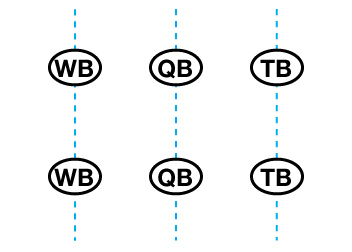
One Step Drill – All RBs take one step and recover (“Bird Dog”) Open Step
Cross-over Step
Spit Step
Lead Step
Load Step
Step @ 2
Step @ 7
Spit Step & Gather
Spin Drill – Full spin progression (difficult to do these steps slowly)
Spit Step & Spin
Step @ 2 & Spin
Step @ 7 & Spin
Spit & Gather – Half Spin Progression
Spit & Gather Right
Spit & Gather Left
Every back is cross trained at each position until he finds a niche. Not all kids can be smooth ball handlers, not all of them are great at catching lead snaps, and not every kid can make that tough cut on an inside reverse. Our kids find their niche through our foot work progression and other drills. We drill these steps every day in preseason and review them at least once a week during the season. How well a player executes the footwork will help us determine where he plays and what series we will run.
When we teach a series of plays we just plug in the foot work and drill the hell out of it.
We Begin our teaching of plays by coaching the series first. The basic alignment of the backs and the footwork to be used in the series are taught and drilled without a ball during our Individual Period at our Footwork Station.
Our concept of the “Individual Practice Period” is a bit different. Our backs rotate through three individual Stations.
1) Blocking Station – All backfield blocks are taught and drilled.
2) Passing Station – All basic pass routes and passing skills are taught (every back and end learn the pass routes in our offense)
3) Series/Footwork Station – take basic alignment and footwork and apply it to the series. Early in the year this is a 30 minute period with three 10 minute rotations. Each group of players spends 10 minutes at each station.
We like this for a couple of reasons. It gives our coaches a chance to see every kid come through his station and assess the player’s skills at that station. Saves time in set up. Coaches and players aren’t wasting time setting up the next drill. Allows us to make an honest judgment of a players overall skills. Last every coach is coaching!
3 Station Indy Drill
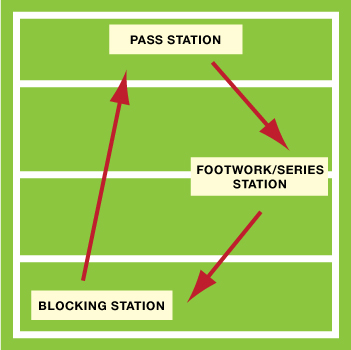
We then begin to install plays. Our plays are installed in the Group Periods. The first period is Inside Run – Traps, Seam Bucks, Wedges, and Counters. The Next Period is Outside Run – Sweeps, Off Tackle, Options and Run/Pass Options. Third period is Pass Period – Play Action and Drop Back.
One of the keys to our simplicity is we move our ball handler to accommodate the series. Our ball handler aligns on a different “Spot”, but uses the same footwork and techniques. The “3 Spot” is the traditional Fullback position and the “4 Spot” is the Tailback position in the Single Wing.
We run three different half spin series. In all three, our ball handler is the same player aligned on a different spot or half spinning in a different direction. Consider that we flip our formations right and left and we have the appearance of six types of half spin actions to the defense. Our players are doing the same thing either half spinning right or left!
QB aligns strong on the 3 (FB) spot for Half Spin Strong and Half Spin towards WB.
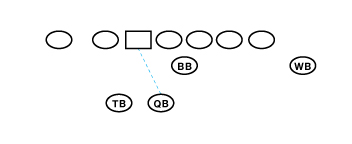
QB aligns Weak on 4 (TB) spot for weak side Half Spin.
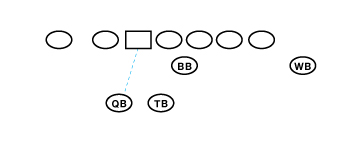
The ability to move the ball handler allows us to do what T formation teams can’t — start the play from a different location. Yet like the T formation’s quarterback, our ball handler remains constant for most series. Not all series. We run power and reverses with a lead snap to our TB or our ball handler.
Because we align on different spots we have the advantage of aligning our best back in the best spot to run Sweep weak or strong without tipping our hand. Our best passer is put in a position to throw the play action or drop back passes. And the best short yardage back may be put in the position to run wedge or seam buck plays.
We mirror all series except the Spin series. There are only so many minutes and trying to keep it simple we feel that Spin is best run only one way due to all the footwork required.
We run half spin weak, half spin strong, and half spin by the 3(FB) spot towards the WB in motion. Next season we plan to include half by the 4 (TB) spot towards the WB in motion (much like the “T” series).
We run some Jet series with flat motion and our ball handler has no new foot work to learn.
Our Drop back pass technique is a bit different than shot gun. We have our passer take a “Spit” step forward to catch the ball. This insures that our passer is not bailing out on the snap and he is concentrating first on catching the ball from the center. It also helps freeze the LBers, (we call it the “Tebow Effect”), is it pass or run. Our passer the takes his drop by pushing off the “Spit” step
Our backs only need to learn which spot they align on, 3(FB) spot or 4 (TB) spot for each series all of our foot work and ball handling remains the same.
We believe that we have found a way to present the defense with many looks and allow our kids to learn a few basic maneuvers. The less you have to learn, the more reps you get, the better you execute what you do.
A multiple yet simple single wing.
Denis Cronin
Gulf Coast Offense
March 10th, 2008
Special thanks to Danny Spain for contacting Coach Hicks
The Gulf Coast Offense (GCO) is a hybrid spread no-huddle offense, which allows us to control the tempo of the game while utilizing numerous styles in our attack. We have blended multiple offensive systems into what we think is the future of offensive football. The GCO has taken concepts from many styles including the R&S, wishbone option, single-wing, and others and molded them into a cohesive system that relies on deception. The GCO is willing to take what a defense is giving us and work against its strength. Our staff and myself really have checked our egos at the door, and are not willing to pound a square peg into a round hole. We go into each game with our basic game plan of running and throwing the football. In my Zen mind I believe balance is the best way to attack a defense and a defensive coordinator. The more elements you make a defense have to prepare for and play against, the more distinct an advantage your offense is allowed.
This is where the single-wing has become a huge part of our offense and our success. For years I have been based out of the four wide receivers and one back set which has been a wonderful and simple plan to attack a defense. With the evolution of defenses and the amount of so-called spread offenses, we felt we needed to add another element to our offensive attack. I went into deep study and discovered the “Yale” or “Beast” formation and immediately added it to our offensive assault, with the thought that it would add a short yardage/goal line addition to our package that we could use only when needed. Well that was the initial plan of attack. We started by utilizing two plays the wedge and sweep and practiced these throughout fall camp. It was our thought we would use this only if all other options had been utilized, such as a 4th down situation with a touchdown needed immediately. The best-laid plans change quickly and our “Elephant” package, as we call it, was utilized four times in our very first game. We scored two huge touchdowns and picked up two huge first downs. The single-wing had made its way to the Gulf Coast and was quickly becoming a monstrous factor in our success. We had a very good season at Delta State in 2007, leading our conference both in total and rushing offense. The “Elephant” package was a vital part of that success. Throughout our 10-2 conference winning campaign we used this package to score 10 touchdowns (about 25% of our total touchdowns) and pick up numerous drive-continuing first downs. What started as a package that was to be utilized once or twice the whole season became one of our staples in the short yardage/goal line situations. As we started with the wedge and sweep the package grew to have a counter as well as a play-action passing game element. Each week we wanted to force the defenses we were playing to have to prepare for a whole different animal, all the while keeping it fresh for our guys. Our players enjoyed the success of the “Elephant” package and loved it when other teams in our conference started to use variations. The success of the package has us, during the off-season, studying new ways to utilize this formation as well as other single-wing additions to help us try and keep a competitive advantage over our opponents. You can always learn in this profession and it’s amazing to me how much past football knowledge and information has been forgotten. Sometimes you have to be willing to go back to the future to discover that little thing that can take you from being good to being great.
The single-wing and its elements will continue to make its way back into college and even professional football. The advent of spread style offenses are bringing to the forefront athletic and mobile quarterbacks who is a threat by throwing and running the football. With these types of mobile quarterbacks the idea of being able to outnumber your opponents in the box will continue. The single-wing gives a great blueprint on how to attack defenses with deception and power. You are also noticing that teams without a mobile QB are utilizing these formations and plays by using other players as the direct-snap quarterback. Any time you can gain an advantage on a defense it’s a great thing. Football is constantly evolving. For every offensive innovation that comes around defenses are finding answers. The spread offenses are the vogue thing in football right now and for them to continue to be hot, coaches will need to go back in time and study the single-wing offenses and what they offer. That being said, I look for continuing evolution of spread systems to have elements of single-wing football all through them. One must embrace the past to truly understand the future. I have added some clips of our package for you to take a look at. If you have any questions please do not hesitate to contact me.
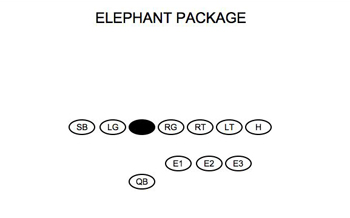
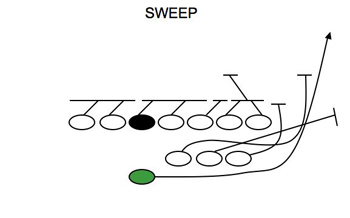
Sweep Rules
OL: Four Point Stances
SB/LG: Outside zone combo
C/RG: Outside zone combo
RT: Outside zone combo
LT/H: Slam block combo to second level
E3: Secure EMOL edge defender
E2: Kick out block on wide edge
E1: lead blocker for QB
QB: Control the snap and follows Elephants on the edge
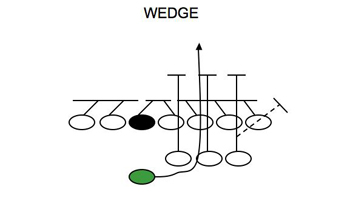
Wedge Rules
OL: Four point stances
SB/LG: Wedge block inside
C/RG: Wedge combo
RT/LT/H: Wedge combo inside
E1 & E2: Find first open seam and block opposite color
E3: Find first open seam and block or EMOL crashing
It is the Elephants’ job to clean any opposite color jersey
QB: Control the snap and follows Elephants
Darrin Hicks
Assistant Football Coach
Delta State University
Dhicks at deltastate dot edu